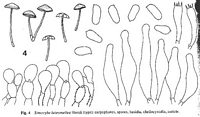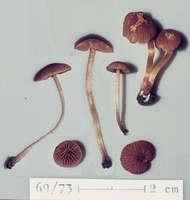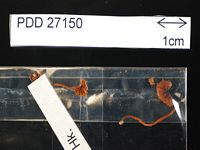|
 Simocybe luteomellea Simocybe luteomellea
BiostatusPresent in region - Indigenous. Endemic
Images (click to enlarge) | 
Caption: ZT69-073 , Holotype
Owner: E. Horak: © Creative Commons Attribution-Noncommercial 3.0 New Zealand | 
Caption: Dried type specimen
Owner: Herb PDD |
Article: Horak, E. (1980). Fungi Agaricini Novazelandiae. X. Simocybe Karsten. New Zealand Journal of Botany 18(2): 189–196 (http://www.rsnz.org/publish/abstracts.php).
Description: Pileus -15 mm, hemispheric, convex or plane, sometimes obtusely campanulate; honey brown, deep yellow-brown, becoming paler with age or drying; dry, smooth to granular, not wrinkled, strongly. striate towards margin, hygrophanous, membranaceous, veil remnants absent. Lamellae (L 6-9, -3), moderately crowded, adnate to emarginate, ventricose; yellow-brown turning umber or fuscous with ochre tint, edge concolorous, fimbriate. Stipe -30 x 1 -1.5 mm, cylindric, equal, central; concolorous with pileus, dark brown towards white villous base; dry, pruinose at apex, smooth in lower portion, veil remnants absent, solid; single or cespitose, in groups. Context yellow-brown. Odour and tastes unpleasant. Spore print brown. Spores 6-7 x 3-3.5 µm, cylindric or obviate, sometimes vaguely phaseoliform, membrane thin-walled, brown, smooth, germ pore none. Basidia 25-30 x 6-7 µm, 4-spored. Cheilocystidia 35-60 x 8-14 µm, fusoid to lageniform, membrane thin-walled, hyaline, pigment absent. Pleurocystidia absent. Caulocystidia like cheilocystidia. Cuticle a celluloderm of ovoid to clavate cells (15-40 x 10-20 µm), membranes thin-walled, not gelatinised, encrusted with brown pigment. Clamp connections on septa.
Habitat: o n bare or moss-covered soil in mixed forests dominated by Podocarpus, Dacrydium, and Weinmannia. New Zealand.
Notes: Simocybe luteomellea is distinctive due to the rather fragile carpophores with yellow-brown, strongly hygrophanous and striated pilei. Macroscopically, therefore, this agaric is most similar to species of Galerina. The cellular pileal cuticle, the fusoid cheilocystidia, and the brown, smooth spores (of various shapes from cylindric to phaseoliform) confirm that this species is a member of the genus Simocybe
|